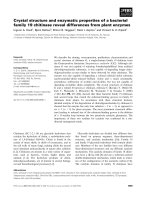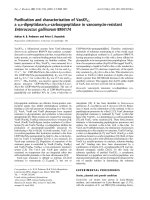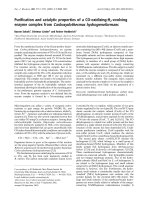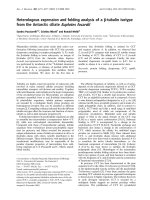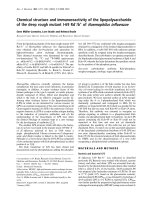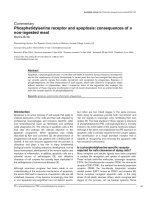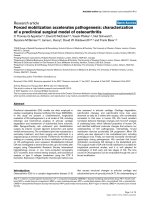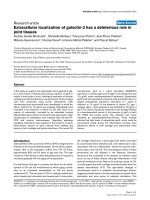Báo cáo y học: " Family Structure and Posttraumatic Stress Reactions: A Longitudinal Study Using Multilevel Analyses" docx
Bạn đang xem bản rút gọn của tài liệu. Xem và tải ngay bản đầy đủ của tài liệu tại đây (267.15 KB, 28 trang )
This Provisional PDF corresponds to the article as it appeared upon acceptance. Fully formatted
PDF and full text (HTML) versions will be made available soon.
Family Structure and Posttraumatic Stress Reactions: A Longitudinal Study
Using Multilevel Analyses
BMC Psychiatry 2011, 11:195 doi:10.1186/1471-244X-11-195
Egil Nygaard ()
Tore Wentzel-Larsen ()
Ajmal Hussain ()
Trond Heir ()
ISSN 1471-244X
Article type Research article
Submission date 9 May 2011
Acceptance date 15 December 2011
Publication date 15 December 2011
Article URL />Like all articles in BMC journals, this peer-reviewed article was published immediately upon
acceptance. It can be downloaded, printed and distributed freely for any purposes (see copyright
notice below).
Articles in BMC journals are listed in PubMed and archived at PubMed Central.
For information about publishing your research in BMC journals or any BioMed Central journal, go to
/>BMC Psychiatry
© 2011 Nygaard et al. ; licensee BioMed Central Ltd.
This is an open access article distributed under the terms of the Creative Commons Attribution License ( />which permits unrestricted use, distribution, and reproduction in any medium, provided the original work is properly cited.
1
Family structure and posttraumatic stress reactions: A longitudinal
study using multilevel analyses
Egil Nygaard
1§
, Tore Wentzel-Larsen
1,2
, Ajmal Hussain
1
, Trond Heir
1
1
Norwegian Centre for Violence and Traumatic Stress Studies, Kirkeveien 166, Building 48,
0407 Oslo, Norway
2
Centre for Child and Adolescent Mental Health, Eastern and Southern Norway, Gullhaug
Torg 4B, 0484 Oslo, Norway
§
Corresponding author
Email addresses:
EN:
TWL:
AH:
TH:
2
Abstract
Background
There is limited research on the relevance of family structures to the development and
maintenance of posttraumatic stress following disasters. We longitudinally studied the effects
of marital and parental statuses on posttraumatic stress reactions after the 2004 Southeast
Asian tsunami and whether persons in the same households had more shared stress reactions
than others.
Method
The study included a tourist population of 641 Norwegian adult citizens, many of them from
families with children. We measured posttraumatic stress symptoms with the Impact of Event
Scale-Revised at 6 months and 2 years post-disaster. Analyses included multilevel methods
with mixed effects models.
Results
Results showed that neither marital nor parental status was significantly related to
posttraumatic stress. At both assessments, adults living in the same household reported levels
of posttraumatic stress that were more similar to one another than adults who were not living
together. Between households, disaster experiences were closely related to the variance in
posttraumatic stress symptom levels at both assessments. Within households, however,
disaster experiences were less related to the variance in symptom level at 2 years than at 6
months.
Conclusions
These results indicate that adult household members may influence one another’s
posttraumatic stress reactions as well as their interpretations of the disaster experiences over
3
time. Our findings suggest that multilevel methods may provide important information about
family processes after disasters.
Keywords: family structure, multilevel analyses, posttraumatic stress reactions, PTSD,
tsunami
4
Family Structure and Posttraumatic Stress Reactions: A Longitudinal Study Using Multilevel
Analyses
Background
There has been increasing interest in the relevance of family factors to the
development of posttraumatic stress disorder (PTSD). In particular, family functioning and
intrafamily support have been considered important [1-7]. Singles may receive less family
support than married persons due to lack of partner [8]. However, the impact of marital status
on posttraumatic stress is ambiguous. Some studies have found married individuals to have
less posttraumatic stress reactions than unmarried individuals [4, 9, 10], while others have
found the opposite effect [11] or no relationship between the variables [12-14]. Whereas one
study found that divorced, separated, or widowed adults are at higher risk for PTSD than
people who are presently married [15], another study found that this risk disappeared when
controlling for other sociodemographic factors and trauma categories [16].
Few post-disaster studies have examined the effect of parental status on the
development of PTSD. Parenthood may influence the risk of developing posttraumatic stress
reactions through processes occurring both in the acute disaster situation [17] and post-
disaster. Such an effect would be in accordance with classical developmental theories of
bidirectional processes between parents and children [18, 19] as well as with more
contemporary developmental theories [20, 21]. However, whereas several studies have found
parental factors to be related to children’s development of PTSD after disasters [22-25],
relatively few longitudinal studies have investigated how parents are influenced by their
children’s level of posttraumatic stress reactions, and these studies have yielded discrepant
results [26-29]. Furthermore, few studies have investigated whether having children relates to
levels of posttraumatic stress. Studies have found that parents had higher levels of
5
posttraumatic stress than nonparents after the Chernobyl disaster [30], after floods [8, 14],
and after the 9/11 attacks [31]. The effect was particularly pronounced for single parents
impacted by the 9/11 attacks [32]. However, other work suggest that parenthood or being in
the company of children were not risk factors for posttraumatic stress reactions after the 2004
tsunami [10, 12].
An alternative method of investigating the relevance of family factors to
posttraumatic stress reactions is by examining similarities in reactions within the family. We
found only three studies that looked at the similarities of couples’ reactions to disasters [14,
33, 34]. All three studies found general mental health or depression to be more similar within
couples than for non-related adults but did not measure specific posttraumatic stress
reactions. Two other studies found child siblings’ posttraumatic stress reactions not to be
more similar than other children’s reactions [35, 36], thus it is unclear if family members do
actually have more similar reactions after disaster than other disaster victims. If more than
one person from a family is included in a study, the participants’ responses are not
independent of each other. Such grouping effects may influence results [37]; therefore, it has
been suggested that disaster research should take grouping into account [38]. Multilevel
analysis, including mixed effect models, is such a statistical method. It takes into account that
some participants come from same subgroup, and thus for example analyze both the
variability between individuals and between families [37]. However, very few disaster studies
have taken into account the mutual experiences and shared reactions of families when
analyzing predictors of posttraumatic stress reactions [10, 14, 39, 40]. Some resolve the
problem by investigating only one participant from each household [7, 31] or by using
sampling weights to correct for selection bias related to number of household members [32].
Others make no adjustments to account for participants from the same household [12, 33].
Thus, the question remains to what extent adult participants living in same household do have
6
more similar reactions than other participants, and thereby are not independent observations,
and how such possible grouping effects should be taken into account. This is important
because the assumption of independent observations is one of the basic assumptions in
standard statistical analyses.
Present study
This longitudinal study investigated posttraumatic stress reactions in Norwegian
adults who experienced the tsunami as tourists in Southeast Asia on December 26, 2004. To
our knowledge, this is the first longitudinal study of posttraumatic stress reactions to account
for the multilevel effect of mutual households or families within the sample. We aimed to
examine the relevance of family structures for adults’ risk of posttraumatic stress reactions
using two strategies: (1) by analyzing family structures as predictors for posttraumatic stress
reactions and (2) by investigating possible similarities in reactions within families. The
specific aims of the study were as follows:
• To investigate differences in posttraumatic stress reactions between married
participants and non-married participants
• To investigate differences in posttraumatic stress reactions between parents and adults
without children
• To investigate, via multilevel analyses, whether adults within shared households had
more similar posttraumatic stress reactions than adults from different households
Methods
Procedure
Shortly after the 2004 tsunami in Southeast Asia, Norwegian nationals who were
evacuated from the disaster-stricken area were registered upon arrival in Norway. A postal
questionnaire was sent to all registered persons 18 years or older (N = 2468) at 6 (T
1
) and 24
7
(T
2
) months post-tsunami. The questionnaire at T
1
included questions concerning exposure,
posttraumatic stress reactions, marital and parental status, and other background variables
[41]. The questionnaire at T
2
included questions about posttraumatic stress reactions [42].
Participants with the same address were assumed to be living in a common household. The
study was approved by the Norwegian Social Science Data Services and The Regional
Committee for Medical Research Ethics.
Participants
While 868 and 1170 responded at T
1
or T
2
respectively, we received questionnaires
for both T
1
and T
2
from 657 respondents. Five of these were excluded due to high levels of
missing data on measures of posttraumatic stress reactions, and eleven more were excluded
due to missing addresses. Therefore, the final sample included 641 participants.
At T
1
, 61.8% of the 641 participants had more than 12 years of education, and 75.5%
were employed. There were multiple participants from the same household in 221 cases
(34.5%). A total of 48.4% of the participants reported that they had traveled with a spouse or
cohabitating partner. A total of 247 (38.5%) participants reported having children under the
age of 18 years at T
1
; 240 participants (40.7%) reported to have responsibility for a child at
time of the disaster, including 25 (4.2%) who had sole responsibility; and 310 (48.4%)
reported to have traveled together with their own child, stepchild or foster child. At T
1,
70.5%
were married or cohabitating, 9.4% were no longer married and 20.1% were single. A total of
50 participants changed marital status from T
1
to T
2
, 27 of which were no longer married or
cohabitating, and 23 participants became married/cohabiter. More descriptive information
about the participants is included in Table 1.
Non-responders at T
1
were more likely than responders to have resided in less
severely affected locations in Southeast Asia [41] and were more often men; however, they
8
were similar in age to responders [43]. The most frequently reported reasons for not
participating were lack of interest or time, followed by lack of relevant experiences [44]. The
final sample did not differ from responders who were excluded from the analyses in family
features (marital status, proportion who had children at T
1
, or proportion of participants from
same household) or posttraumatic stress reactions at T
1
. However, the excluded responders
reported a lower average level of posttraumatic stress reactions at T
2
than the analyzed
sample (M(SD)
excluded
= 0.85 (0.82), M
included
= 1.05 (0.83), t(1396) = 2.89, p = .004).
Measures
Exposure and immediate response to the disaster. Based on earlier work [45],
questions regarding a broad spectrum of tsunami experiences were assessed in the
questionnaire 6-months post-tsunami. Based on earlier evaluations of the exposure
experiences as risk factors [41], four questions were included in the present study to measure
exposure: whether a participant had witnessed multiple dead bodies, had witnessed
abandoned children, had been caught, touched or chased by waves, or had experienced the
death of a family member or friend. Each question was answered no (0) or yes (1). Two
questions were used to assess immediate subjective response to the disaster: fear, and feelings
of helplessness, with both items rated on a five-point scale (0 = not at all, 1 = little, 2 =
moderate, 3 = intense, 4 = extreme). These two items represented immediate response to the
disaster, corresponding to the A2 criterion for PTSD from the DSM-IV [46].
Posttraumatic stress reactions. The Impact of Event Scale – Revised (IES−R) [47]
was included at both assessments to measure the level of posttraumatic stress reactions during
the previous two weeks. The IES−R includes 22 items with five response alternatives (0 = not
at all, 1 = little, 2 = moderately, 3 = quite a bit, 4 = extremely). Total mean scores were based
on all items. The psychometric properties of the IES−R have been extensively evaluated and
deemed acceptable, with internal consistency within subscales reported to be between .81 and
9
.91, test-retest reliability to be between .52 and .86, and correlation with other measures of
posttraumatic stress reactions to be between .53 and .57 [48]. Similar acceptable measures or
reliability have been found in a Norwegian non-clinical sample [49]. The internal consistency
was high in the present sample (Cronbach’s α = .96 and .95 at T
1
and T
2,
respectively).
Data analysis
We excluded participants who were missing more than four replies to questions about
posttraumatic stress reactions. For the remaining participants, missing values for these
variables were replaced using expectation maximization algorithms (EM algorithms), which
took into account a participant’s scores on items within the same symptom cluster, the scores
of the other respondents, and the correlations between items [50]. Dropout analyses were
done using χ
2
-tests for categorical data and student t-tests for continuous data.
Chi-square tests were used for bivariate analyses of grouped variables. The effects of
marital status and parental status on posttraumatic stress reactions were first tested with
univariate mixed effects models adjusted for exposure and immediate subjective distress
during the disaster. The effect of single parenthood was tested with a mixed effects model
with random effects for differences between household and for individuals within household.
There were no random effects regressors. Fixed effects regressors included both marital
status and parental status, and also adjustment for the six questions concerning exposure and
immediate subjective distress during the disaster. Mixed effects models were also used to
analyze whether household members reported more similar posttraumatic stress reactions
than participants from different households. The effect of household was tested with two
mixed effects models, first an unadjusted model without predictors and next with a model
adjusted for exposure and immediate subjective distress during the disaster. In this way, all
models controlled for participants who lived in the same household. This multilevel approach
10
means that the regression model has error terms at two levels, the individual level and the
household level.
Similarity between household members is presented by intra-class correlations (ICC)
computed from the random effects between and within household in the mixed effects
models. ICC was calculated by dividing unexplained variance between households by the
sum of unexplained variance between households and between individuals within same
household. ICC can vary between 0 and 1. An ICC close to 0 indicates that household
members are no more similar than other participants, whereas an ICC of 1 indicates that
household members have identical responses. Confidence intervals for ICC were based on
parametric bootstrapping and computed as bootstrap percentile intervals using 10,000
bootstrap replications. Bootstrapping is a general procedure that e.g. makes it possible to
compute confidence intervals in cases where other methods are not easily available [51].
All tests were two-tailed, with a significance level of p ≤ .05. Statistical analyses were
performed using PASW Statistics, version 18, and R, version 2.10.1, with packages nlme and
boot.
Results
Marital status and parenthood
Marital status at T
1
was not related to the level of posttraumatic stress reactions at T
1
or at T
2
. The mean values (SD) of IES−R at T
1
and T
2,
respectively, were 1.1 (0.8) and 1.0
(0.8) for married/cohabiters, 1.1 (0.8) and 1.1 (1.0) for single persons who had been
previously married, and 1.1 (0.9) and 1.0 (0.8) for single persons who had not been
previously married, corresponding to an average response close to little on the 0 – 4 scale
(F(2, 515.2) = 0.02, p = .98 at T
1
and F(2, 512.5) = 1.74, p = .18 at T
2
).
11
Furthermore, parents at T
1
did not differ from non-parents in their level of
posttraumatic stress reactions at T
1
or at T
2
. The mean values (SD) of IES−R at T
1
and T
2,
respectively, were 1.2 (0.9) and 1.1 (0.8) for non-parents and 1.1 (0.8) and 1.0 (0.8) for
parents (t(503.8) = 1.77, p = .08, b(95% CI) = 0.10 (-0.01, 0.22) at T
1
and t(469.4) = 0.91, p =
.36, b(95% CI) = -0.06 (-0.07, 0.18) at T
2
).
To examine whether posttraumatic stress reactions differed between single parents
and couples with children, marital status (single, divorced, separated, or widowed versus
couple), parenthood (having a child versus not having a child), and the interaction effect
between marital status and parenthood, were entered simultaneously into mixed effects
models. No significant main effects or interaction effects on posttraumatic stress reactions
were found at either of the two study times.
Further analyses were conducted to investigate whether parents and non-parents
differed in their exposure or immediate emotional reactions during the tsunami. Compared to
non-parents, parents did not witness more abandoned children, were not taken more often by
the waves, and did not feel more helplessness during the tsunami. However, parents were less
likely to have witnessed multiple dead bodies (χ
2
(1, N = 587) = 5.38, p = .02), were more
likely to have lost family or friends in the tsunami (χ
2
(1, N = 641) = 8.97, p = .003), and felt
more fear during the tsunami (t(505.2) = 2.39, p = .02, b(95% CI) = 0.28 (0.05, 0.52)).
Mutual household
At both time points, adults from the same household reported more similar levels of
posttraumatic stress reactions than adults from different households. The unadjusted intra-
class correlation (ICC) for posttraumatic stress reactions in the mixed effects model was .53
at T
1
and .47 at T
2
(Table 2). The confidence intervals for ICC at both times were sufficiently
far from zero to indicate a considerable effect of mutual household. To examine whether
similarities between members of the same household could be due to a greater number of
12
shared experiences during the tsunami, we performed mixed effects models adjusted for the
six questions concerning exposure and immediate emotional responses. Similar results were
found, with ICC of .56 and .35 at T
1
and T
2,
respectively (Table 2).
The decrease in unadjusted and adjusted ICC from T
1
to T
2
was not significant.
However, the decrease in adjusted ICC was close to significant (Table 2). This decrease was
related to changes in how much tsunami experiences explained variance in posttraumatic
stress reactions between individuals within families. Taking into account the disaster
experiences, the unexplained variances at T
1
were reduced both at the individual level
(36.0%) and at the household level (44.8%). At T
2,
unexplained variance between households
had decreased (48.4%), whereas unexplained variance between individuals within the same
household had decreased less when taking into account the disaster experiences (9.0%)
(Table 2). Thus, tsunami experiences were still related to posttraumatic stress reactions of
families at T
2
, but not as much to the reactions of individuals within families.
Discussion
In the present study, neither marital status nor parental status was related to the level
of posttraumatic stress. Adults living in the same household had more similar levels of
posttraumatic stress than adults not living together. The association between household
members with regard to posttraumatic stress did not change from T
1
to T
2.
Disaster
experiences were associated with posttraumatic stress of individuals within families at T
1,
but
there was almost no such association at T
2
. Thus, the impact of each family member’s
original disaster experiences on the level of posttraumatic stress decreased over time.
Neither single nor married parents had higher levels of posttraumatic stress reactions
than adults without children. This is in accordance with findings in a similar study of Swedish
tourists during the tsunami [10] and a study of Sri Lankan adults who were displaced after the
13
tsunami [12]. However, other studies have found parenthood to be related to higher levels of
reactions after a nuclear accident [30], floods [8, 14], and the 9/11 attack [31]. One possible
reason for the discrepant findings is that our study, like the Swedish tsunami study, examined
disaster survivors who were repatriated to stable home societies; thus, parents had fewer post-
tsunami worries about their children’s wellbeing and future. The fact that parents experienced
both more fear than nonparents and were less likely to have witnessed dead bodies may have
influenced our results as well. While the parents may have been more anxious because they
worried about the wellbeing of their children, they may also have protected their children and
thus also themselves from witness experiences. Thus, the findings indicate that it is possible
that having children may both be related to factors enhancing and factors decreasing the risk
of posttraumatic stress reactions [17], with such effects possibly nullifying each other.
Marital status was not related to an elevated or reduced level of posttraumatic stress
reactions. This was surprising as singles may get less family support, and social support has
been found to be a major protective factor against posttraumatic stress reactions [52, 53].
However, adults living in the same household had more similar levels of posttraumatic stress
reactions than adults not living in the same household, with ICC indicating that
approximately half of the variation in posttraumatic stress reactions was related to differences
between adults within the same household. This is consistent with theories indicating that
humans in relationships influence each other and often have converging interpretations of
mutual experiences [54-56]. In most natural disasters, all members of a family are exposed,
and in most instances, the members of the family live together after the disaster. Therefore,
not only do family members have more resemblance in their disaster experiences than
unrelated people, but they will also influence each other’s coping strategies, recollections,
interpretations and post-disaster reactions. However, child siblings have been found to have
unrelated posttraumatic stress reactions, both in the same population as the present sample
14
and after common disaster experiences during an earthquake [35, 36]. It is unclear why adult
family members’ reactions should be more similar than the reactions of child siblings. The
difference between couples and child siblings may be age related and/or role related. Children
are developmentally different from adults in how they are aware of their surroundings and
their internal experiences [57]. It is also possible that couples communicate more and listen
more to each other about the traumatic event and later reactions than siblings because of their
cooperating role, especially their parental role. Whereas siblings may actively disagree,
parents may seek cooperation and converging interpretation with their partner and co-
caregiver.
We did not find any increase in household concordance of posttraumatic stress
reactions from T
1
to T
2
. This indicates that most of the family converging processes happened
within six months of the disaster. However, the experiences during the disaster were less
related to the posttraumatic stress reactions of the individuals within households at follow up
than at the first assessment. These results indicate that family members influence each other’s
interpretations of the disaster over time. Thus, individual differences in interpretation of and
reaction to the disaster diminish over time. The results thus indicate that over time, an
individual’s posttraumatic stress reactions may be influenced more by family members’
interpretations and memories of the trauma than by actual exposure during the disaster.
Methodological considerations
This study had some methodological advantages. Almost all Norwegians who were
tourists in the disaster area were invited to participate, reducing sample selection bias. The
participants experienced a single, easily identifiable trauma and were largely protected from
secondary adversities because they were able to quickly return to unaffected home
communities. The tsunami-related processes between the persons in the household should
therefore be less influenced by processes outside the household.
15
There was a relatively low response rate. However, due to the directionality of the
dropout bias, the included participants seem to represent most of the heavily exposed
Norwegian tourists in the tsunami-stricken areas [44].
The information was gathered by the use of postal questionnaires. Thus, participants
from same household may have interacted during the filling out process. This may have
influenced the results.
This study is limited to symptoms of posttraumatic stress. Other consequences of the
disaster exposure, such as depression or functional impairment, were not analyzed or
discussed. Children’s levels of posttraumatic stress reactions were not controlled for in the
present analyses, even though parent’s and children’s posttraumatic stress reactions are often
related [58]. Other traumatic experiences were not taken into account [59].
The present article has evaluated marital status at first assessment as a risk factor for
later posttraumatic stress reactions. Additional analyses indicated that change in marital status
was not related to level of posttraumatic stress reactions (results not shown). Additional
analyses (not shown) did also find that neither traveling with children nor having
responsibility for children during the tsunami were related to level of posttraumatic stress
reactions.
Conclusions
Adults living in the same household reported similar posttraumatic stress reactions. In
addition, family members’ interpretations of the disaster seemed to merge over time. This
may be positive if the family moves in a favorable direction, but it indicates that for
individuals who are not improving from posttraumatic stress reactions, it is important to
investigate how their family interprets and perhaps contributes to the non-improving mental
health. This study emphasizes the importance of a family-centered care that takes on an
16
ecological grounded perspective when treating adults with posttraumatic stress reactions after
common disaster experiences.
Methods of analysis that take into account the grouping of stress reactions within
households provided valuable information about possible family processes. The study thus
supports the importance of taking group levels into account when analyzing and discussing
findings from studies including more than one participant from same household [38].
Competing
interests
The authors declare that they have no competing interests
Authors contributions
EN performed the statistical analysis and drafted the manuscript. TWL performed the
statistical analysis and was involved in the revision of the manuscript. AH collected data and
revised the manuscript. TH participated in the conception, design, and revision of the
manuscript and was the general supervisor for the project. All authors read and approved the
final manuscript.
Acknowledgements
The collection of the data was funded by The Research Council of Norway, and the analysis
and writing of the report was funded by the Norwegian Centre for Violence and Traumatic
Stress Studies. These institutions had no further role in analysis and interpretation of data; in
the writing of the manuscript; or in the decision to submit the manuscript for publication.
17
References
1. McFarlane AC: Family functioning and overprotection following a natural disaster: The
longitudinal effects of post-traumatic morbidity. Australian and New Zealand Journal of
Psychiatry 1987, 21:210-218.
2. Norris FH, Uhl GA: Chronic stress as a mediator of acute stress: The case of Hurricane Hugo.
Journal of Applied Social Psychology 1993, 23(16):1263-1284.
3. Catapano F, Malafronte R, Lepre F, Cozzolino P, Arnone R, Lorenzo E, Tartaglia G, Starace F,
Magliano L, Maj M: Psychological consequences of the 1998 landslide in Sarno, Italy: A
community study. Acta Psychiatrica Scandinavica 2001, 104(6):438-442.
4. Fullerton CS, Ursano RJ, Kao TC, Bharitya VR: Disaster-related bereavement: Acute
symptoms and subsequent depression. Aviation, Space, and Environmental Medicine 1999,
70(9):902-909.
5. Wickrama KAS, Wickrama KAT: Family context of mental health risk in tsunami affected
mothers: Findings from a pilot study in Sri Lanka. Social Science & Medicine 2008,
66(4):994-1007.
6. Schwarz ED, Kowalski JM: Malignant memories. Effect of a shooting in the workplace on
school personnel's attitudes. Journal of Interpersonal Violence 1993, 8(4):468-485.
7. Kaniasty K, Norris FH: Longitudinal linkages between perceived social support and
posttraumatic stress symptoms: Sequential roles of social causation and social selection.
Journal of Traumatic Stress 2008, 21(3):274-281.
8. Solomon SD, Bravo M, Rubio-Stipec M, Canino G: Effect of family role on response to
disaster. Journal of Traumatic Stress 1993, 6(2):255-269.
9. Ursano RJ, Fullerton CS, Kao TC, Bhartiya VR: Longitudinal assessment of posttraumatic
stress disorder and depression after exposure to traumatic death. Journal of Nervous and
Mental Disease 1995, 183(1):36-42.
18
10. Wahlström L, Michelsen H, Schulman A, Backheden M: Different types of exposure to the
2004 tsunami are associated with different levels of psychological distress and
posttraumatic stress. Journal of Traumatic Stress 2008, 21(5):463-470.
11. Brooks N, McKinlay W: Mental health consequences of the Lockerbie disaster. Journal of
Traumatic Stress 1992, 5(4):527-543.
12. Ranasinghe PD, Levy BR: Prevalence of and sex disparities in posttraumatic stress disorder
in an internally displaced Sri Lankan population 6 months after the 2004 Tsunami. Disaster
Medicine and Public Health Preparedness 2007, 1(1):34-41.
13. Hollifield M, Hewage C, Gunawardena CN, Kodituwakku P, Bopagoda K, Weerarathnege K:
Symptoms and coping in Sri Lanka 20-21 months after the 2004 tsunami. British Journal of
Psychiatry 2008, 192(1):39-44.
14. Gleser GC, Green BL, Winget C: Prolonged psychosocial effects of disaster: A study of
Buffalo Creek. New York, NY: Academic Press Inc.; 1981.
15. Kessler RC, Sonnega A, Bromet E, Hughes M, Nelson CB: Posttraumatic stress disorder in the
National Comorbidity Survey. Archives of General Psychiatry 1995, 52(12):1048-1060.
16. Breslau N, Peterson EL, Poisson LM, Schultz LR, Lucia VC: Estimating post-traumatic stress
disorder in the community: Lifetime perspective and the impact of typical traumatic
events. Psychological Medicine 2004, 34(5):889-898.
17. Weisæth L: Collective traumatic stress: Crisis and catastrophes. In: Stress in health and
disease. edn. Edited by Arnetz BB, Ekman R. Weinheim, Germany: WILEY-VCH Verlag GmbH
& Co. KGaA; 2006.
18. Lerner RM: Concepts and theories of human development, 2nd edn. New York, NY:
Newbery Award Records, Inc.; 1986.
19. Stern DN: The interpersonal world of the infant. A view from psychoanalysis and
developmental psychology. New York, NY: Basic Books Inc.; 1985.
19
20. Siegel DJ: The developing mind. Toward a neurobiology of interpersonal experience. New
York, NY: The Guilford Press; 1999.
21. Berk LE: Child development, 8th edn. Boston, MA: Pearson; 2009.
22. Bloch DA, Silber E, Perry SE: Some factors in the emotional reaction of children to disaster.
American Journal of Psychiatry 1956, 113(5):416-422.
23. McFarlane AC: Posttraumatic phenomena in a longitudinal study of children following a
natural disaster. J Am Acad Child Adolesc Psychiatry 1987, 26(5):764-769.
24. Green BL, Korol M, Grace MC, Vary MJ, Leonard AC, Gleser EC, Smithson-Cohen S: Children
and disaster: Age, gender and parental effects on PTSD symptoms. Journal of the American
Academy of Child & Adolescent Psychiatry 1991, 30:945-951.
25. Catani C, Jacob N, Schauer E, Kohila M, Neuner F: Family violence, war, and natural
disasters: A study of the effect of extreme stress on children's mental health in Sri Lanka.
BMC Psychiatry 2008, 8:33-42.
26. Koplewicz HS, Vogel JM, Solanto MV, Morrissey RF, Alonso CM, Abikoff H, Gallagher R,
Novick RM: Child and parent response to the 1993 World Trade Center bombing. Journal of
Traumatic Stress 2002, 15(1):77-85.
27. Gershoff ET, Aber JL, Ware A, Kotler JA: Exposure to 9/11 among youth and their mothers in
new york city: enduring associations with mental health and sociopolitical attitudes. Child
Dev 2010, 81(4):1142-1160.
28. Phillips D, Featherman DL, Jinyun L: Children as an evocative influence on adults' reactions
in terrorism. Applied Developmental Science 2004, 8(4):195-210.
29. Kilmer RP, Gil-Rivas V: Responding to the needs of children and families after a disaster:
Linkages between unmet needs and caregiver functioning. American Journal of
Orthopsychiatry 2010, 80(1):135-142.
20
30. Havenaar JM, Rumyantzeva GM, van den Brink W, Poelijoe NW, van den Bout J, van
Engeland H, Koeter MW: Long-term mental health effects of the Chernobyl disaster: An
epidemiologic survey in two former Soviet regions. American Journal of Psychiatry 1997,
154(11):1605-1607.
31. Stuber J, Fairbrother G, Galea S, Pfefferbaum B, Wilson-Genderson M, Vlahov D:
Determinants of counseling for children in Manhattan after the September 11 attacks.
Psychiatric Services 2002, 53(7):815-822.
32. Stuber J, Resnick H, Galea S: Gender disparities in posttraumatic stress disorder after mass
trauma. Gender Medicine 2006, 3(1):54-67.
33. Vila G, Witkowski P, Tondini MC, Perez-Diaz F, Mouren-Simeoni MC, Jouvent R: A study of
posttraumatic disorders in children who experienced an industrial disaster in the Briey
region. European Child & Adolescent Psychiatry 2001, 10(1):10-18.
34. Kristensen P, Heir T, Herlofsen PH, Langsrud Ø, Weisæth L: Parental mental health after the
accidental death of a son during military service: 23-year follow-up study. Journal of
Nervous and Mental Disease in press.
35. Asarnow J, Glynn S, Pynoos RS, Nahum J, Guthrie D, Cantwell DP, Franklin B: When the earth
stops shaking: Earthquake sequelae among children diagnosed for pre-earthquake
psychopathology. Journal of the American Academy of Child & Adolescent Psychiatry 1999,
38(8):1016-1023.
36. Nygaard E, Jensen TK, Dyb G: Posttraumatic stress reactions in siblings after mutual
disaster: Relevance of family factors. Journal of Traumatic Stress 2010, 23(2):278-281.
37. Goldstein H: Multilevel mixed linear model analysis using iterative generalized least
squares. Biometrika 1986, 73(1):43-56.
38. Norris FH: Disaster research methods: Past progress and future directions. Journal of
Traumatic Stress 2006, 19(2):173-184.
21
39. Dyb G, Jensen TK, Nygaard E: Children's and parents' posttraumatic stress reactions after
the 2004 tsunami. Clinical Child Psychology and Psychiatry 2011, 16(4):621-634.
40. Nomura Y, Chemtob CM: Effect of maternal psychopathology on behavioral problems in
preschool children exposed to terrorism: Use of generalized estimating equations to
integrate multiple informant reports. Archives of Pediatrics & Adolescent Medicin 2009,
163(6):531-539.
41. Heir T, Weisæth L: Acute disaster exposure and mental health complaints of Norwegian
tsunami survivors six months post disaster. Psychiatry 2008, 71(3):266-276.
42. Heir T, Piatigorsky A, Weisæth L: Longitudinal changes in recalled perceived life threat after
a natural disaster. The British Journal of Psychiatry 2009, 194(6):510-514.
43. Heir T, Sandvik L, Weisæth L: Hallmarks of posttraumatic stress: Symptom Z-scores in a
tsunami-affected tourist population. Psychopathology 2009, 42(3):157-164.
44. Hussain A, Weisaeth L, Heir T: Nonresponse to a population-based postdisaster postal
questionnaire study. Journal of Traumatic Stress 2009, 22(4):324-328.
45. Weisæth L: The stressor-response relationship. In: Post-traumatic stress disorder. edn.
Edited by Giller EL, Weisæth L. London: Bailliere Tindal; 1996: 191-216.
46. DSM–IV-TR: Diagnostic and statistical manual of mental disorders, 4th ed., text rev. edn.
Washington, DC: American Psychiatric Association.; 2000.
47. Weiss DS, Marmar CR: The Impact of Event Scale-Revised. In: Assessing psychological
trauma and PTSD. edn. Edited by Wilson JP, Keane TM. New York, NY: Guilford Press; 1997:
399-411.
48. Weiss DS: The Impact of Event Scale-Revised. In: Assessing psychological trauma and PTSD.
edn. Edited by Wilson JP, Keane TM. New York, NY: The Guilford Press; 2004: 168-189.
22
49. Eid J, Larsson G, Johnsen BH, Laberg JC, Bartone PT, Carlstedt B: Psychometric properties of
the Norwegian Impact of Event Scale-Revised in a non-clinical sample. Nordic Journal of
Psychiatry 2009:1-7.
50. Schafer JL: Analysis of incomplete multivariate data. London, UK: Chapman & Hall; 1997.
51. Efron B, Tibshirani R: Bootstrap methods for standard errors, confidence intervals, and
other measures of statistical accuracy. Statistical Science 1986, 1(1):54-77.
52. Ozer EJ, Best SR, Lipsey TL, Weiss DS: Predictors of posttraumatic stress disorder and
symptoms in adults: A meta-analysis. Psychological Bulletin 2003, 129(1):52-73.
53. Brewin CR, Andrews B, Valentine JD: Meta-analysis of risk factors for posttraumatic stress
disorder in trauma-exposed adults. Journal of Consulting and Clinical Psychology 2000,
68(5):748-766.
54. Sherif M: The psychology of social norms. New York, NY: Harper; 1936.
55. Asch SE: Social psychology. Englewood Cliffs, NJ: Prentice Hall; 1952.
56. Nichols MP: Family therapy, concepts and methods, 9th edn. Boston, MA: Pearson
Education, Inc.; 2010.
57. Salmon K, Bryant RA: Posttaumatic stress disorder in children: The influence of
developmental factors. Clinical Psychology Review 2002, 22(2):163-188.
58. Alisic E, Jongmans MJ, van Wesel F, Kleber RJ: Building child trauma theory from
longitudinal studies: A meta-analysis. Clinical Psychology Review 2011, 31(5):736-747.
59. Neuner F, Schauer E, Catani C, Ruf M, Elbert T: Post-tsunami stress: A study of
posttraumatic stress disorder in children living in three severely affected regions in Sri
Lanka. Journal of Traumatic Stress 2006, 19(3):339-347.
23
Table 1
Descriptive statistics of the major study variables (N = 641)
Variable n (%) / M (SD)
Number of participants from household at T
1
One
Two
Three
Four
420 (65.5%)
196 (30.6%)
21 (3.3%)
4 (0.6%)
Mean age at time of tsunami (SD) 43.4 (12.9)
Sex
Men
Women
288 (44.9%)
353 (55.1%)
Marital status at T
1
Married or cohabitating
Divorced, separated, or widowed
Single
Missing
434 (70.5%)
58 (9.4%)
124 (20.1%)
25
Had children under 18 years of age at T
1
No
Yes
394 (61.5%)
247 (38.5%)
Witnessed abandoned children
No
Yes
415 (70.2%)
176 (29.8%)
24
Missing 50
Witnessed multiple dead bodies
No
Yes
Missing
463 (78.9%)
124 (21.1%)
54
Caught, touched or chased by waves
No
Yes
Missing
404 (64.0%)
227 (36.0%)
10
Death of family member or friend
No
Yes
585 (91.3%)
56 (8.7%)
Mean immediate response of fear during tsunami (SD) 2.5 (1.4)
a
Mean immediate response of helplessness during tsunami (SD) 2.6 (1.4)
b
Mean posttraumatic stress reactions at T
1
(SD) 1.1 (0.8)
Mean posttraumatic stress reactions at T
2
(SD) 1.0 (0.8)
a
n = 596.
b
n = 597.
